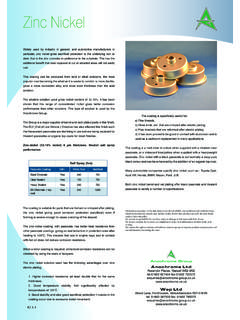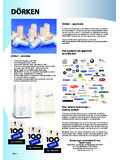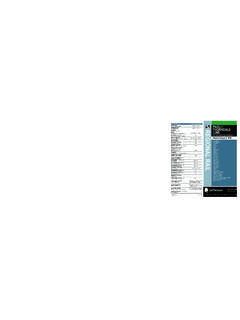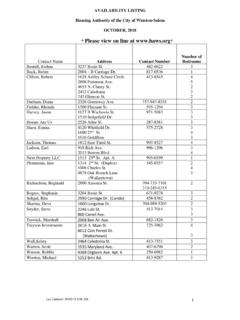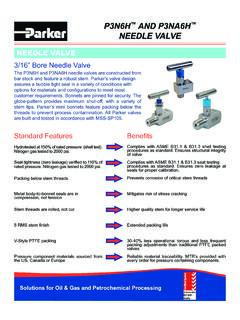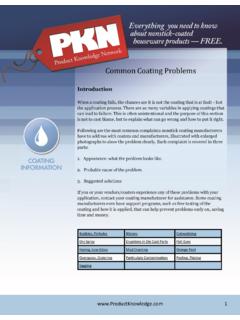Transcription of applying coatings of 25 microns/0.001 inch or …
1 From the development of the first Xylan product (1010), whitford has modified the basic formulation to solve specific problems. This has led to new materials and combinations of materials so that, today, there are more than 3,000 different formulations of Xylan. Few products are as beneficial in so many ways as the wide range of Xylan coatings . This very diversity, however, means that properties can vary widely. Xylan dry-film lubricants can solve numerous problems, including friction/wear, corrosion, temperature extremes, sticking, vibration, galvanic activity, electrical insulation and conductivity. The selection of a coating depends on determining the problem of the application (wear, heat, corrosion, etc.)
2 And matching it with the material that most effectively solves the Fluoropolymer-rich surfaceFluoropolymer and binder matrixMolecular binder layerSubstrateA matrix coating is one in which some soft ingredients, such as the lubri-cant (PTFE), are enveloped in others (the matrix) such as harder, more wear-resistant binders. If PTFE, for example, is used by itself (with-out the matrix), and is exposed to a wear surface, it quickly wears away. Com-bined with the matrix, however, the new structure solves the engineering problems as it protects itself. Matrix coatings are adjustable. The specific properties of Xylan formulations depend on the materials used to form the total coating and their ratio to one another.
3 By judicious selection of compounds, we can formulate a coating to have superior release, wear resistance, chemical resistance, high conductivity, causes heat, wear and loss of energy in dynamic applications. In severe circumstances, friction can cause overheating and seizure. Friction also causes brinelling, galling, scoring, and underloading of fasteners. Driveline vibration and chatter result from friction. In these cases, stick/slip motion is usually the cause. This unstable sliding motion occurs at very slow speeds, when friction increases above the force causing the movement and motion stops, then drops below the moving force, at which point motion restarts.
4 Deformation or destruction of delicate mechanisms such as lock components can be caused by excessive friction. Friction coefficients (measured by mating surfaces rubbing against a coating ) typically vary from about for PTFE materials to about for Moly coatings , although values as low as have been measured for some Xylan coatings are particularly useful when temperatures exceed the operating limits of conventional mineral and synthetic oils. Because Xylan coatings are based on resin systems with a wide range of temperature capabilities, they can be used from cryogenic levels to 260 C/500 F, with many being stable for brief periods at 315 C/600 F.
5 Where galling, abrasion, and high energy loss due to friction are anticipated, consider applying coatings of 25 inch or more to minimize friction and wear. Potential applications include rotors for compressors, air-cylinder pistons, hinges, sliding bearings. The best coating choice is the one which provides the desired coefficient of friction and the maximum pressure/velocity (P/V) a Xylan coating in a bearing cavity in which a fluid lubricant is also used reduces friction losses in the bearing to the lowest possible level because Xylan is oleophobic (it sheds oil).During rotation, viscous shear forces within the bearing are reduced slightly.
6 Thus, instrument bearings or other systems in which minimum bearing friction is critical can benefit from a thin coating ( inch). Excessive friction is also detrimental to bolted joints, in that much of the tightening torque is expended overcoming thread-to-thread and bearing-face friction. In these situations, if the bolt is not properly tensioned (preloaded), the joint can be unexpectedly weak in service. In addition, improperly fastened parts are subject to backout when vibration occurs. coating the threads reduces the makeup torque by as much as 65 percent. Because of its toughness and corrosion resistance, a PTFE-matrix in a thermosetting binder is preferred for these applications.
7 Industrial CoatingsCoatings available from Anochrome Technologies LtdWood Lane, Fordhouses, Wolverhampton WV10 8 HNtel: 01902 567567 fax: 01902 LtdWood Lane, Fordhouses, Wolverhampton WV10 8 HNtel: 01902 397333 fax: 01902 reduction and vibration generates noise. Vortices trailing high-speed impeller blades, impacting gear teeth, bearings spinning in races, slapping piston skirts, plungers sliding against the walls of actuators, and other sources of vibration are dampened when treated with Xylan. Under impact, noise generation is reduced. In most cases, noise generation is effectively reduced by coatings of 25 to 40 to inch. When corrosion is not a consideration, these films may be applied in one coat, although thicker coats may have greater energy absorbing capacity.
8 If excessive noise is the primary problem, multiple coats of Xylan (up to 60 microns / ) may be applied to achieve optimum results. Caution should be taken to avoid excessive thickness, since the coating could be subject to delamination or tearing. The choice of the best Xylan formulation for noise reduction depends on the problem. If corrosion is not a problem, apply a soft coating such as Xylan 1006; otherwise use P-92 primer and a topcoat of Xylan 1014. A manufacturer of domestic dryers used a bearing coated with Xylan 1010 to replace an oil-impregnated bearing. The problem with the old bearing was that, after approximately one year of service, the oil migrated out of the bearing and the dryer developed an annoying squeak.
9 The coating not only provided the required lubrication, but also eliminated the squeak. Non stick should not be confused with low friction: the two are different. Friction results from two surfaces sliding across each other and is measured by a dimensionless number that describes the reduction of drag (force) between the sliding parts. Release is the property of a surface which results in the inability of substances to adhere to it. It is a function of surface energy that can be measured by the angle of contact between the surface and a drop of liquid. The greater the contact angle, the lower the surface energy, and the greater release a coating has.
10 Release is generally associated with cookware, coated to release food materials. But release is equally vital to industrial processes such as thermoforming, rubber moulding, auto-motive and adhesive many applications, build-up of foreign particles is a far greater problem than high bearing loads or corrosion. Examples: carburettor shafts, choke plungers, butterfly spindles, conveyor parts, instrument probes, fluid injectors, copy and printer rollers. Build up of dirt, ice, soot, scale, food and other foreign material can jam valve butterflies, throttle shafts, float elements, orifices, plungers, solenoids and other mechanisms. If contamination of a surface is anticipated, it can be minimized with a thin coating of Xylan, which enables the part to shed the not confuse low frictionwith releaseLow Friction reductionNon stick (release) propertiesCoatings available from Anochrome Technologies LtdWood Lane, Fordhouses, Wolverhampton WV10 8 HNtel: 01902 567567 fax: 01902 LtdWood Lane, Fordhouses, Wolverhampton WV10 8 HNtel: 01902 397333 fax: 01902 following table can be used to give a guide to some of the different coatings available within the whitford range.
